











ONE GROWER PUBLISHING, LLC THE PEANUT PRODUCER'SMARKETING & PRODUCTION MAGAZINE www.peanutgrower.com PEANUT GROWER The JUNE 2024 Well Deserved Recognition A Tribute To Retiring NCSU Entomologist, Dr. Rick Brandenburg Rain At Planting? Be Ready For Early Disease Pressure APRES Arachis Session Named To Honor Dr.Charles Simpson Variety Memorializes Florida Grower Precision Ag On A New Level

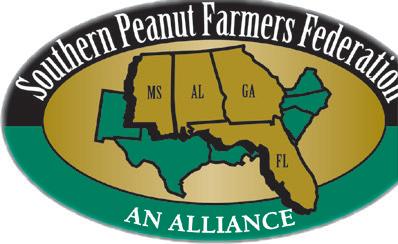

Rollin’ River on the Room reservations at The Westin can be made online at
. For detailed conference and registration information, visit www.southernpeanutfarmers.org or scan the QR code above. The Westin Savannah Harbor Golf Resort & Spa Savannah, Georgia • SOUTHERN PEANUT GROWERS CONFERENCE july 17-19, 2024
https://book.passkey.com/e/50678321


















Sign

Precision Ag On A New Level
The new UGA-Tifton lab will fuel innovation in precision agriculture.
Well Deserved Recognition
The Wild Arachis Species Special Session of the APRES annual meeting is now named to honor Dr. Charles Simpson.
Season Update
Heavy rains at planting can mean early disease spore dispersal and Valor injury.
Your contributions to the industry — and especially the peanut growers of North Carolina — are sincerely appreciated.
New Variety Honors Avid Grower
Named for Arnold ‘Arnie’ Forrester, the University of Florida released a high-yield potential cultivar with normal oleic oil chemistry.
JUNE 2024 • THE PEANUT GROWER / 3 | @PEANUTGROWER 10 4 Editor’s Note Stumbling on a theme 5 News Briefs House, Senate release Farm Bill priorities 8 Market Watch With planting underway, markets are still quiet Volume 36 • Number 6 Cover photo provided by John Cason, Peanut Breeding and Genetics, Texas A&M AgriLife Research, Stephenville, Texas. ONE GROWER THE PEANUT PRODUCER'SMARKETING & PRODUCTION MAGAZINE www.peanutgrower.com PEANUT GROWER The JUNE 2024 Well Deserved Recognition A Tribute To Retiring NCSU Entomologist, Dr. Rick Brandenburg Rain At Planting? Be Ready For Early Disease Pressure APRES Arachis Session Named To Honor Dr.Charles Simpson Variety Memorializes Florida Grower Precision Ag On A New Level Features 10
12
15
16 Thank You,
Brandenburg
Dr.
19
Departments 20 New Products
residuals JUNE 2024
Firm up weed control and overlap
Stay Connected
up
monthly e-newsletter
peanutgrower.com to have exclusive industry news and content delivered directly to your inbox.
PeanutGrower @PeanutGrower @ThePeanutGrower
for the
at
www.peanutgrower.com
EDITORIAL/PRODUCTION
Editor Amanda Huber ahuber@onegrower.com
Copy Editor Cassidy Nemec cnemec@onegrower.com
Art Director Ashley Kumpe
Digital Content Manager Katie Guthrie
ADMINISTRATION
Publisher/Vice President Lia Guthrie (901) 497-3689 lguthrie@onegrower.com
Associate Publisher/Editor-In-Chief Carroll Smith (901) 326-4443
Associate Publisher/Sales Scott Emerson (386) 462-1532 semerson@onegrower.com
Audience Services Kate Thomas (847) 559-7514
Production Manager David Boyd dboyd@onegrower.com
For subscription changes or change of address, call (847) 559-7578 or email peanutgrower@omeda.com
EDITORIAL ADVISORY BOARD
Scott Monfort
Extension Agronomist University of Georgia
Dell Cotton
Peanut Growers Cooperative Marketing Assn., Franklin, VA
Kris Balkcom
Agri-Program Associate
Auburn University
Dan Anco
Extension Peanut Specialist
Clemson University
Emi Kimura
Extension Agronomist
Texas A&M University
David Jordan
Extension Agronomist North Carolina State University
Glen Harris
Extension Agronomist University of Georgia
Jason Ferrell
Extension Weed Specialist University of Florida
ONE GROWER PUBLISHING, LLC
Mike Lamensdorf PRESIDENT/TREASURER
Lia Guthrie PUBLISHER/VICE PRESIDENT
The Peanut Grower (ISSN 1042-9379) is an agribusiness magazine for U.S. peanut producers. Published in eight monthly issues, January through July and November. Annual subscriptions are $40.00. Single Copy price is $5.00. Annual overseas subscriptions are $70.00, including Canada/Mexico. Periodicals postage paid at at Memphis, Tennessee, and at additional mailing o ices. Copyright © 2024 One Grower Publishing, LLC, all rights reserved except where otherwise noted. The Peanut Grower ® is a registered trademark, which reserves all rights granted by the U.S. Patent and Trademark O ice in association with the registration. POSTMASTER: SEND ADDRESS CHANGES TO OMEDA COMMUNICATIONS, CUSTOMER SERVICE DEPARTMENT, P.O. BOX 1388, NORTHBROOK, IL 60065-1388. All statements, including product claims, are those of the person or organization making the statement or claim. The publisher does not adopt any such statement or claim as its own, and any such statement or claim does not necessarily reflect the opinion of the publisher. Printed in the USA.
One Grower Publishing, LLC, also publishes Cotton Farming, Rice Farming, Soybean South and Corn South
One Grower Publishing, LLC
875 W. Poplar Ave., Suite 23, Box 305 Collierville, TN 38017


Stumbling On A Theme Editor’s Note
This issue of Peanut Grower developed a theme quite innocently enough. As an industry, we are pretty good at recognizing both the pioneers and the everyday person in the trenches who bring a lot to the table for peanut growers.
David Jordan, North Carolina State University Extension agronomist, is always quick to let me know when a long-time researcher, Extension personnel or other person important to Virginia-Carolina farmers is retiring. In the early spring, he let me know that 2024 would be the year Rick Brandenburg, long-time NCSU Extension entomologist, is retiring. We decided this issue would be good for a tribute article, and it can be found on page 16.
 Amanda Huber Editor, e Peanut Grower
Amanda Huber Editor, e Peanut Grower
Next, an article came to my email from the University of Georgia Cooperative Extension media newswire that caught my attention. Dr. William D. “Bill” Branch was being inducted into the Georgia Agriculture Hall of Fame. I was more or less surprised this hadn’t happened already because you would be hard pressed to think of someone more important to the peanut industry in Georgia than this stalwart peanut breeder. Congratulations, Dr. Branch, it is recognition well deserved.
At this point, I still had not connected the two things as an actual theme, and then the definitive item came — an exciting announcement that the inaugural Charles Simpson Wild Arachis Species Session would be held at the 2024 American Peanut Research and Education Society annual meeting, July 9-11, at the Omni Oklahoma City hotel.
The Wild Arachis Species Session would be named to honor the pioneer who is most responsible for collecting and preserving wild peanut species, Dr. Charles Simpson. His contributions to the peanut industry worldwide are simply immeasurable. There it was — a theme.
Whenever I get the opportunity to write about Dr. Simpson’s contributions to the peanut industry, it is always with a sense of awe, which may sound kitsch, but I love this industry so much and do not know where it would be without him. It would not be brimming with excitement at the new state of peanut breeding and the ability to use the genetic resources in wild species for modern varieties.
Special thanks to Shyam Tallury, curator of the U.S. Department of Agriculture’s peanut collection in Griffin, Georgia, who proposed naming the session after Simpson, for much of the information, and also APRES president Rebecca Bennett, research plant pathologist with the USDA Peanut and Small Grains Research Unit in El Reno, Oklahoma, The Peanut Research Foundation executive director Steven Brown and John Cason, assistant professor of Peanut Breeding and Genetics at the Texas A&M AgriLife Research station in Stephenville, for their contributions.
4 / THE PEANUT GROWER • JUNE 2024 PEANUTGROWER.COM


News Briefs
House, Senate Release Farm Bill Priorities
In the first full week of May, both the Senate and House agriculture committees released priorities and proposals on the Farm Bill.
On the Senate side, agriculture committee chairwoman Debbie Stabenow (D-MI) says their version of The Rural Prosperity and Food Security Act makes investments to strengthen the farm safety net; supports beginning, underserved and small farmers and ranchers; and focuses assistance on actual farmers, not billionaire and foreign entities. It also invests in nutrition assistance, increases access to fruits and vegetables and supports people on their path to self-sufficiency while cracking down on fraud. It seeks to improve rural health care, childcare and education, expand access to high speed internet and lower costs for families and businesses.
On ag commodities, it would provide certainty to farmers by making payments more likely to trigger under the Price Loss Coverage and the Agriculture Risk Coverage programs and improves emergency disaster assistance. Under the bill, all major covered commodities will see at least a 5% increase in reference prices during the 2024 Farm Bill, with many seeing 10%-15% increases.
House ag committee chairman Glenn “GT” Thompson (R-PA) also released a title-by-title overview of their policies and priorities for the 2024 Farm Bill. Their bill, too, reflects a commitment to the American farmer and viable pathways to funding those commitments, and is equally responsive to the politics of the 118th Congress.
For ag commodities, it aids farmers in managing risk and provides assistance following precipitous declines in commodity prices. Through the reauthorization and enhancement of commodity, marketing loan, sugar, dairy and disaster programs, producers are provided some certainty in times of unpredictability.
Additionally, it seeks to increase support for the PLC and ARC programs to account for persistent inflation and rising costs of production. It provides authority to expand base acres to include producers who currently cannot participate in ARC/PLC. It modernizes marketing loans and sugar policy and bolsters dairy programs to continue providing vital assistance. It also seeks to enhance standing disaster programs and expand eligibility for assistance.
Sen. Warnock Happy With Dem’s Proposal
U.S. Senator Reverend Raphael Warnock (D-GA) celebrated the Senate democrats’ proposed Farm Bill, and he says the framework includes victories for commodities, including reference price increases, market assistance loan increases and additional base allocation.
Warnock says it provides southern commodities with at least a 5% increase in reference price with many commodities seeing double-digit increases some years. It also includes the Senator’s Southern Commodities, Rates, Opportunities, Production and Support (Southern CROPS) Act to allocate base acres for underserved farmers and improve marketing assistance loan rates.
APC Applauds USAID’s $200M Food Aid Purchase
The American Peanut Council welcomes the announcement by USAID that it will make a special $200 million purchase of ready-to-use therapeutic food as part of U.S. food aid programs. The additional purchase will have a tremendous impact on getting peanut-based, lifesaving nutrition to millions of children around the globe.
By both value and volume, 25% of RUTF is made using peanuts. As part of the American Peanut Council’s export work, the organization promotes the use of U.S. peanuts in RUTF and educates
In Brief
• Senate, House release di erent Farm Bill proposals.
• USAID pledges $200 million purchase of peanut-based nutritional aid.
• Producers and industry members appointed to standards board.
• Oklahoma peanut tour planned ahead of APRES.
• Peanut Butter & Jesus community ministry is spreading.
• AGCO partnership supports mental health resources for farmers, ag communities.
stakeholders about the exceptional nutritional value of peanuts as its primary ingredient.
“In light of devastating events currently taking place around the world, the American Peanut Council applauds USAID’s decision to purchase additional RUTF to help feed those who are most impacted,” says Peter Vlazakis, APC senior director of international programs.
“The U.S. peanut industry is committed to helping address global hunger by providing RUTF to disadvantaged and developing countries where children are facing severe malnutrition. This additional purchase by USAID will go a long way toward supporting that mission.”
RUTF is a nutritionally dense paste given to children suffering from acute to severe malnutrition. It does not require water or refrigeration, can be administered at home and can rehabilitate a child under the age of five in just eight weeks. Peanut-based RUTF combines 500 calories and micronutrients to help children gain weight quickly and has a taste profile that children enjoy. It has saved tens of millions of lives around the globe.
JUNE 2024 • THE PEANUT GROWER / 5 | @PEANUTGROWER


News Briefs
AGCO Foundation Partnership Supports Farmer Mental Health
The AGCO Agriculture Foundation, a private entity with the vision to prevent and relieve hunger through sustainable agriculture development, announced a new partnership with The Do More Agriculture Foundation.
With a commitment of $150,000 for three years, the AGCO Agriculture Foundation is dedicated to supporting farming communities across the United States and Canada, with an emphasis on connecting farmers to mental health resources and increasing awareness of their capabilities and benefits. The partnership exemplifies a shared goal to cultivate resilience, provide support and eliminate the stigma associated with mental health in the agriculture community.
“We recognize the distinct pressures that farmers face in their day-to-day work. As a foundation, we are committed to supporting programs and initiatives that make a real difference in the lives of farmers and their families,” says Roger Batkin, foundation chairman. “By growing the farmer mental health initiative, we hope to further address the growing mental health crisis among farmers and provide them with the assurance that help is available.”
Through this partnership, the AGCO Agriculture Foundation is now the presenting sponsor for the #TalkItOut video series, which aims to foster open discussions on mental health issues relevant to the agricultural community. The partnership will also lead to the creation of co-branded mental health support stickers equipped with QR codes to link farmers to instant local mental health resources.
Additionally, the partnership will support mental health
According to USAID, approximately 300 million people will need humanitarian assistance this year due to Russia’s war on Ukraine, famine in Gaza and Sudan and environmental factors. Further, it is estimated 45 million children will be affected with what is known as “child wasting,” the most acute, life-threatening form of malnutrition.
Tour Oklahoma Agriculture Prior To APRES Meeting
For an immersive journey into the heart of Oklahoma’s vibrant agricultural landscape, sign up to attend the tour on Monday, July 8. Tour planners say it offers an unforgettable day filled with enriching experiences and fascinating insights.

workshops and training. The workshops focus on raising awareness about mental health, addressing challenges and providing farmers with tools to manage stress and increase overall mental wellbeing.
“We are thrilled about the potential of our partnership with the AGCO Agriculture Foundation and the profound impact it will have on farming communities,” says Megz Reynolds, executive director of Do More Agriculture. “The commitment to supporting mental health initiatives aligns perfectly with our mission, enabling us to expand our reach and provide critical resources to even more farmers in need of mental health support.”
The tour begins at 8:30 a.m., departing the Omni Oklahoma City Hotel. The first stop will be the Schantz Family Farm in Hydro, Oklahoma, to see variety trials, including the latest innovations and techniques shaping the future of agriculture firsthand. Next, the tour will visit a Birdsong buying point in Eakly, Oklahoma, and delve into the processes of production and distribution.
The tour will continue on to the Oklahoma State University’s Caddo Research Station in Fort Cobb where lunch will be served prior to a tour of the station. Participants will return to the Omni Oklahoma City Hotel by approximately 4 p.m.
To sign up for the tour, visit www. apresinc.com.
USDA Announces Standards Board
The U.S. Department of Agriculture has announced the appointment of 18 members to serve on the Peanut Standards Board. To maintain staggered terms of office, six appointees each will serve a one-year, two-year and three-year term of office. Nine appointees are producers and the other nine industry members. The appointments are effective immediately. Appointed members serving a one-year term expiring June 30, 2025, are producers – Larry Ford, Greenwood, Fla.; Greg Hughes, Seminole, Texas; David L. Davenport, Greenville, N.C. and industry members – Dr. Darlene Cowart, Blakely, Ga.; Dr. Michael Franke, Brownfield, Texas; and Carl Gray, Severn, N.C.
6 / THE PEANUT GROWER • JUNE 2024 PEANUTGROWER.COM


News Briefs
Appointed members serving a twoyear term expiring June 30, 2026, are producers – Marty McLendon, Leary, Ga.; Aaron Martin, Brownfield, Texas; Donny L. Lassiter, Conway, N.C. and industry members – Rachel Santos, Douglas, Ga.; Lupe De Lira, Seagraves, Texas; Ryan Ososki, Alexandria, Va.
Appointed members serving a threeyear term expiring June 30, 2027, are producers – Carl Sanders, Brundidge, Ala.; Michael Newhouse, Clarendon, Texas; Paul Rogers, Wakefield, Va. and industry members Caleb Waver Smithville, Ga.; Shelly Nutt, McKinney Texas; Ashley M. Patterson, Suffolk, Va.
The Peanut Standards Board provides quality assurance reviews and inspections, conducts food safety audits and develops national standards for peanuts — all in support of America’s peanut industry supply chain. More information about the board is available on the Agricultural Marketing Service Peanut Standards Board webpage.
Peanut Butter & Jesus Is Spreading
Peanut butter & Jesus is a community ministry that had as a mission to feed hungry kids in the neighborhood. Over time, the ministry has accelerated to other communities. There are now 35
to 40 chapters around the United States, including Georgia, Oklahoma, Texas, Kentucky, Louisiana and Florida, says Tony McBrayer, chief financial officer of Tifton’s Peanut Butter & Jesus. “It’s my dream that maybe one day even another country would start up a chapter of Peanut Butter & Jesus,” he says.
The local ministry, begun in 2017, provides a sack lunch with an inspirational message to hungry children and families every Saturday in Tift County, Georgia. The lunches include a peanut butter and jelly sandwich, a snack, a juice and a Bible-based message, oftentimes in cartoon form to get children’s attention. Volunteers pack and deliver the lunches to needy families. The familiar lime-green vans can be spotted in neighborhoods across the county. Peanut Proud and Golden Boy have provided peanut butter. For resources and information on how to start a chapter of Peanut Butter & Jesus, visit peanutbutterjesus.org.
WIC Rule Excludes PB For Infants
On April 9, the U.S. Department of Agriculture announced the final rule on revisions in the Women, Infant and Children (WIC) Food Packages. Despite the 2020 Dietary Guidelines for Americans stating, “Introducing pea-
nut-containing foods in the first year reduces the risk that an infant will develop a food allergy to peanuts,” peanut foods are not included in the infant food package for ages 6-11 months.
“This is a setback for allergy prevention because the science is well supported, and lower-income children are particularly vulnerable to food allergies,” says NPB chairman and Arkansas grower Greg Baltz.
Research shows that high-risk infants — those with severe eczema, an egg allergy or both — need to start peanut foods as early as four to six months and continue at least three times per week as they grow. The researchers behind the LEAP Study are more convinced today the window for prevention is short and closes early, meaning waiting is not an option.
NPB will push forward and has scheduled a meeting with USDA-FNS to determine ways to still reach this important WIC audience.
Moreover, NPB continues to align with partners to engage and educate local WIC offices and staff nutrition consultants so they can champion early introduction among participants. Resources for promoting early introduction to WIC staff and families can be found at PreventPeanutAllergies.org

JUNE 2024 • THE PEANUT GROWER / 7 | @PEANUTGROWER


Market Watch
With Planting Underway, Markets Are Still Quiet
The peanut market is very quiet. Currently, raw-shelled peanuts are available from 68 to 72 counts, and buyers come in as needed for spot sales. The market seems to believe that supplies will be below average causing the price to remain higher than normal.
Some coverage was needed through the summer, but buyers think markets will weaken as the planted crop germinates and progresses. Any prolonged dry weather from June forward will push new crop prices higher from the current 59, 58 and 57 cents per pound for jumbos, mediums and splits, respectively.
A 3.1-million-ton crop of good quality peanuts is needed as carryover from the 2023 crop will be below historic levels. Many buyers have taken some coverage on the new crop and are now in a waitand-see pattern until the crop is planted and begins progressing.
With the anticipated short supply and higher costs of production, contract offers were above the $500 to $525 per-ton level for Southeast and Virginia-Carolina runner-type peanuts. Virginias were also higher in the V-C area and in the Southwest. Some buying points reported heavy action, especially if a sheller/buying point pool was an option offering hopes that the price would be higher later.
Buyers continue to point to cotton prices at 75 to 80 cents per pound as the reason there should be an increase in peanut planting and, therefore, lower prices for raw-shelled kernels.
Planting Intentions
The U.S. Department of Agriculture says farmers intend to plant 6,000 more acres than last year for a total of 1.65 million. Farmers in Georgia and Alabama, the two top producing states, are expected to plant 50,000 more acres
in 2024 compared with the prior year.
Farmers in Texas report intentions to plant 65,000 fewer acres than last year. Smaller states like Missouri, Florida and South Carolina intend to increase their respective peanut planted areas, offsetting the loss of acres in Texas. However, some growers were not in agreement with USDA’s numbers and that Texas’ decline would be offset and then some.
The first USDA planted crop estimate had acreage down 1% with continued problems with Texas’ drought. Meanwhile, on the 7% increase in the Southeast, most agreed this would not flood the market, but if harvest was abundant, the carryforward would steady the market.
Production Estimates
USDA is estimating a production of 2.9 million tons. Total peanuts available for the market are 4,008,500 tons. Markets for disappearance are domestic food, crush, exports and seed/residual for a total of 3,031,500 tons. Ending stocks could drop 4% to 977,000 tons. Domestic food usage has declined 0.6%, with exports increasing 21% to 725,000 tons.
Contracts are not likely to be offered
 J. Tyron Spearman Contributing Editor, e Peanut Grower
J. Tyron Spearman Contributing Editor, e Peanut Grower
again until certified or reported peanut acreage is posted by the Farm Service Agency one month after the July 15 deadline. Shellers are not likely to offer lower shelled prices until they get a more accurate accounting of crop tonnage.
Meanwhile, other storm clouds could impact progress. No. 1 is weather. Texas continues to miss rains in the Southwest, while floods and storms are mangling other areas. The Southeast has received early rains to get the crop off to a good start, but more will be needed by pegging time.
Domestic Markets
Another factor that bothers industry leaders is the sudden drop in domestic consumption. USDA’s utilization charts show a 3% decline from this past year. An eight-month comparison saw peanut usage in candy down 2.5%, peanut snacks down 13% and peanut butter down 0.4%...all leading to a decline of 2.9%.
The cause seems to be inflation, which has most all food items costing much more. The cost of food ingredients has also increased to manufacturers, and that includes peanuts and peanut butter.
8 / THE PEANUT GROWER • JUNE 2024 PEANUTGROWER.COM
2024 Est. Acreage (-1%) .................................................. 1,651,000 acres 2024 Est. Production (+7.4%) ............................................ 2,990,000 tons 2023 Market Loan .............................................................. 2,294,257 tons 2023-24 In Loan (5-7-24) .................................................... 1,137,796 tons 2023-24 Domestic Usage (8 Mo.) .................................................. – 2.9 % 2023-24 Exports (7 Mo.) .................................................................... +33% NATIONAL POSTED PRICE (per ton) Runners - $424.68, Spanish - $413.41, Valencia and Virginias - $428.31
Leading Marketing Indicators (May 8, 2024)


Market Watch
Export Markets
Export demand for U.S. peanuts is tightening the supply before the 2024 peanut crop can be grown and warehoused. With four months remaining in the year, the industry could reach the USDA estimate of 725,000 metric tons farmer stock. The top two markets continue strong with 25% volume going to Mexico and 22% to Canada. The American Peanut Council export team made major accomplishments in The Netherlands (+318%) and the United Kingdom (+135%).
More than 85% of U.S. peanut exports currently go to mature markets. The next step change will need to come from new
Peanut Yield Trends
categories in existing geographies or new geographic markets. Shipments are up 21% over last year.
Growth in total peanut kernel imports by Mexico has slowed, but peanut butter consumption is still nascent. Peanut butter also appears to be driving European and United Kingdom peanut consumption growth.
In Argentina, the current crop looks good, and USDA forecasts production at 1.35 million metric tons in both 2023/24 and the next harvest on 400,000 acres. Yields are expected to average in the range of 3.4 to 3.5 tons per hectare. Recent high humidity, coupled with drizzle, have slowed harvest.
The U.S. Department of Agriculture released the 2023 production estimates in January showing U.S. peanut yields down 7% from 2022 at 3,740 pounds per acre. As shown in Figure 1, a majority of states’ peanut yields declined in 2023 relative to the previous year. Alabama and Florida both saw 17% decreases in their yields. Georgia had a 3% decline to 4,070 pounds per acre. Yields were down largely due to the drought that persisted in the South throughout the latter part of the peanut-growing season. Arkansas led the way with a record-high yield of 5,800 pounds per acre, in part because most peanuts were irrigated.
Putting into context where this year’s yield falls historically, let’s look at peanut yield trends since 1970 (Figure 2). The 2023 yield is the lowest since 2016. Over the entire 1970-2023 period, peanut yields increased by 36 pounds per acre annually, on average, but with considerable variation. From 1970 to 2000, peanut yields increased by an average of seven pounds per year. Then in 2001, peanut yields reached 3,000 pounds per acre for the first time. Over the subsequent decade, peanut yields increased by 57 pounds per year on average. The substantial increase from 2001-2012 is likely driven by the introduction of Georgia-06G, a high-yielding, runner-type peanut cultivar that was released in 2006 and soon gained a significant market share in the Southeast. In 2012, peanut yields surpassed 4,000 pounds per acre for the first time. However, over the past 12 years, peanut yields have been flat and averaged 3,948 pounds per acre. In fact, the 2012 mark has yet to be topped.
Peanut yields are an even more critical aspect of profitability due to increased input prices. Production costs are expected to remain elevated in 2024 at $598 per ton, assuming yields equal the five-year average. This means that even with peanut
‘‘
Keep the faith. As one commentator said this week, “peanuts are medicine.” That’s quite a compliment for the humble peanut!
Peanut leaders are planning on a Farm Bill this year that includes a reference price increase and base acres for new growers. Keep the faith. As one commentator said this week, “peanuts are medicine.” That’s quite a compliment for the humble peanut!
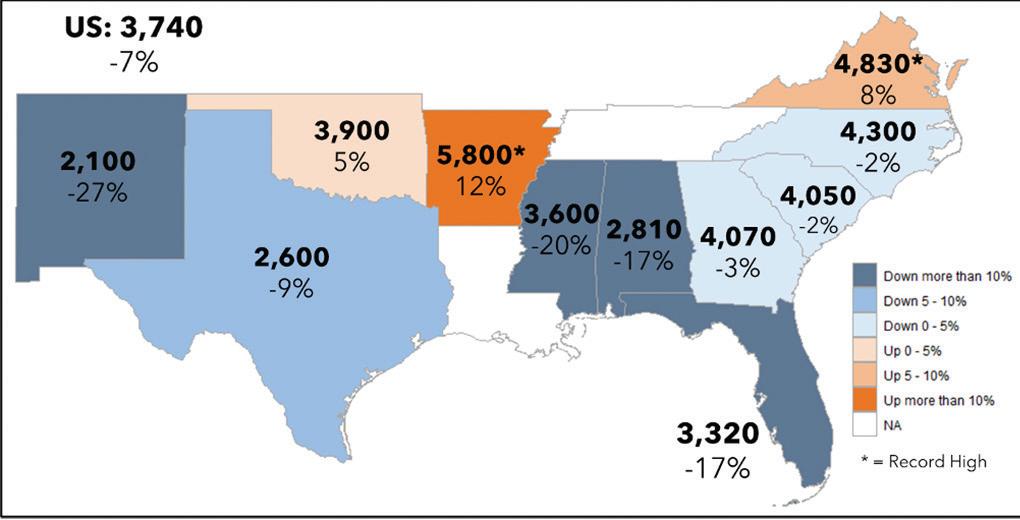

prices expected to reach a decade-high of $550 per ton, producers would still likely operate at a loss. Strong yields would help lower these breakeven prices, but the recent yield volatility raises concerns that this might not occur.
Article by Wendiam Sawadgo, Auburn University.
JUNE 2024 • THE PEANUT GROWER / 9 | @PEANUTGROWER
Farm Bill
Figure 1
Figure 2

Precision Ag On A New Level
The new UGA-Tifton lab will fuel innovation in precision agriculture.
With the global population expected to increase from 8 billion to 9.7 billion by 2050, agricultural researchers and producers are faced with the looming challenges of how to feed a growing world.
A key tool in the effort to propel Georgia’s No. 1 industry into the future is the expanding field of integrative precision agriculture.
At the University of Georgia Tifton campus, the new Tifton Integrative Precision Agriculture Research, Education and Demonstration Laboratory will be the first of its kind in the Southeast to provide state-of-the-art collaborative spaces, topof-the-line autonomous equipment and job training for the next generation of agricultural leaders.
Advancing Integrative Precision Agriculture
The $3.03 million project will include a working lab, electronic labs and office spaces to increase collaboration among graduate students, scientists and industry. The 12,500-squarefoot space previously served as the Tifton Rural Development
Center before sitting vacant for nearly two decades.
Last month, plans for the lab were signed through this year’s bipartisan government funding package, championed by Rep. Drew Ferguson (GA-03) and carried on the Senate side by Sens. Jon Ossoff and Rev. Raphael Warnock.
“We are thrilled for this opportunity to demonstrate the latest technologies across Georgia’s commodities,” says UGATifton assistant dean Michael Toews. “These labs and collaborative spaces will be within walking distance to agricultural plots, providing stakeholders the ability to see and test technologies for adoption on their farms.”
Sen. Ossoff says, “Food security is national security. Georgia farmers feed the nation and the world. Working alongside Senator Reverend Warnock and Congressman Ferguson, we are delivering new resources with bipartisan support to help the University of Georgia create a new precision agriculture demonstration lab in Tifton and help our state’s top industry continue to thrive. I thank assistant dean of UGA’s Tifton campus Dr. Michael D. Toews for bringing this proposal to my office and for his leadership.”
10 / THE PEANUT GROWER • JUNE 2024 PEANUTGROWER.COM
The Tifton Integrative Precision Agriculture Research, Education and Demonstration Laboratory will provide innovative collaborative spaces, top-of-the-line autonomous equipment and job training for the next generation of agricultural leaders.
Driving Innovation And Outreach
Georgia’s agricultural size, breadth and multiple climate zones make it a natural center for agricultural technology development. UGA’s College of Agricultural and Environmental Sciences is working to advance precision agriculture across the state and nation through teaching, research and outreach. In spring 2022, the university established the Institute for Integrative Precision Agriculture to serve as a conduit to connect agricultural technology development within UGA and with outside partners like universities and agribusinesses.
In Tifton, repurposing the Rural Development Center will allow CAES students and researchers to solve global agricultural issues, such as targeted irrigation, and meet the need to share advanced agricultural practices among rural communities.
“While CAES projects like the climate-smart 4-D Farm focus on research, this lab will highlight products that have already made it to market and are currently benefiting industry,” Toews says. “Beyond our students, researchers and industry partners, this demo lab will create pathways for outreach to Tift County.—.and rural areas across Georgia — as a whole.”
Bringing The Future To The Farm
The climate-smart 4-D Farm is being developed as part of a $4 million grant from the U.S. Department of Agriculture’s National Institute of Food and Agriculture. The project, The Digital and Data-Driven Demonstration Farm (4-D Farm): Juxtaposition of Climate-Smart and Circular Innovations for Future Farm Economies, is part of NIFA’s investment in regional innovations for climate-smart agriculture and forestry.
Led by principal investigator Glen Rains, the project involves an interdisciplinary team across CAES, including researchers in sustainable precision agriculture, data science, livestock management, grass and forage management, crop production, UGA Extension and education programming, and autonomous and intelligent rover research and development. Two sub awards were given to Abraham Baldwin Agricultural College and Clemson University. The project also includes a contracted social economist from Kansas State University.
Construction on the Tifton Integrative Precision Agriculture Research, Education and Demonstration Laboratory is expected to begin in 2025. Learn more about UGA’s efforts in Integrative Precision Agriculture at the website iipa.uga.edu. PG
Article By Jordan Powers, public relations coordinator and writer for UGA’s College of Agricultural and Environmental Sciences.
The Tifton Integrative Precision Agriculture Research, Education and Demonstration Laboratory and the climate-smart 4-D Farm will bring new technologies to the farm in the future. Currently, growers can benefit from current precision ag technologies found on their blog, at site.extension.uga.edu/ precisionag/, as follows.
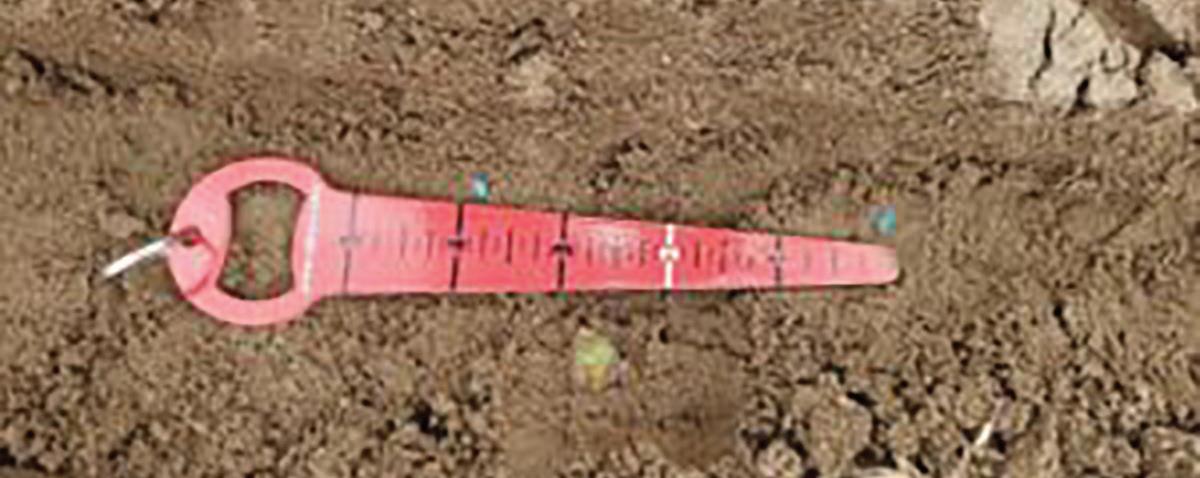
Planting Calculations
UGA’s Simer Virk o ers some useful formulas to determine seeding rate, seed spacing, number of seeds per foot or assess emerged plant population based on stand counts in certain length of the row. Alternatively, provided tables can be used to determine seeding rate based on seed spacing or assess plant population based on number of plants per foot length of the row.
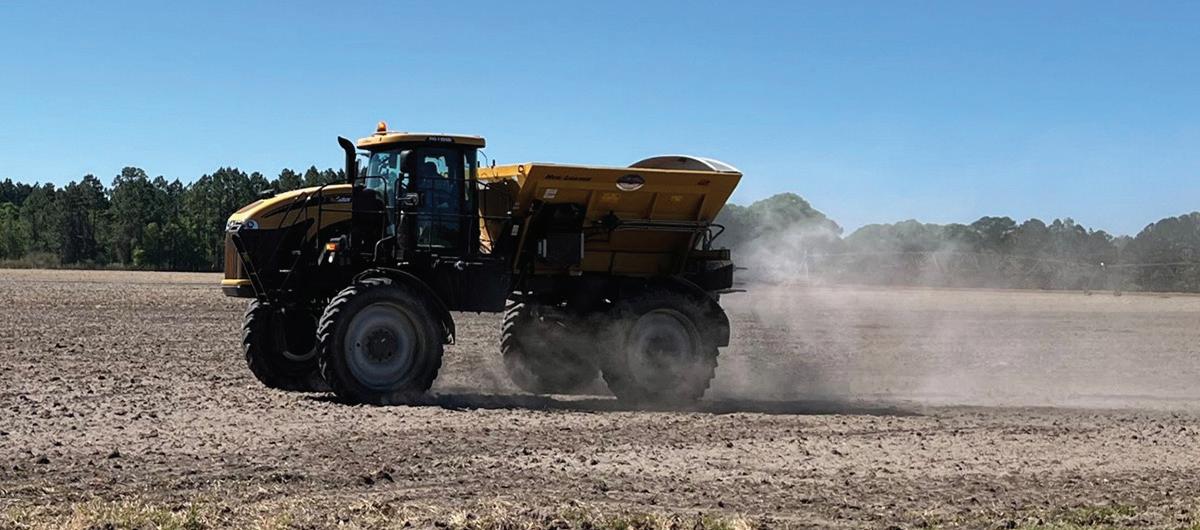
Variable-Rate Fertilizer Application Considerations
How accurate are the variable-rate applications when these spreaders are flying through the field? Simer Virk investigates fertilizer application ground speed and accuracy, plus other factors. He o ers help in understanding and in making adjustments for more accurate variable-rate fertilizer applications.
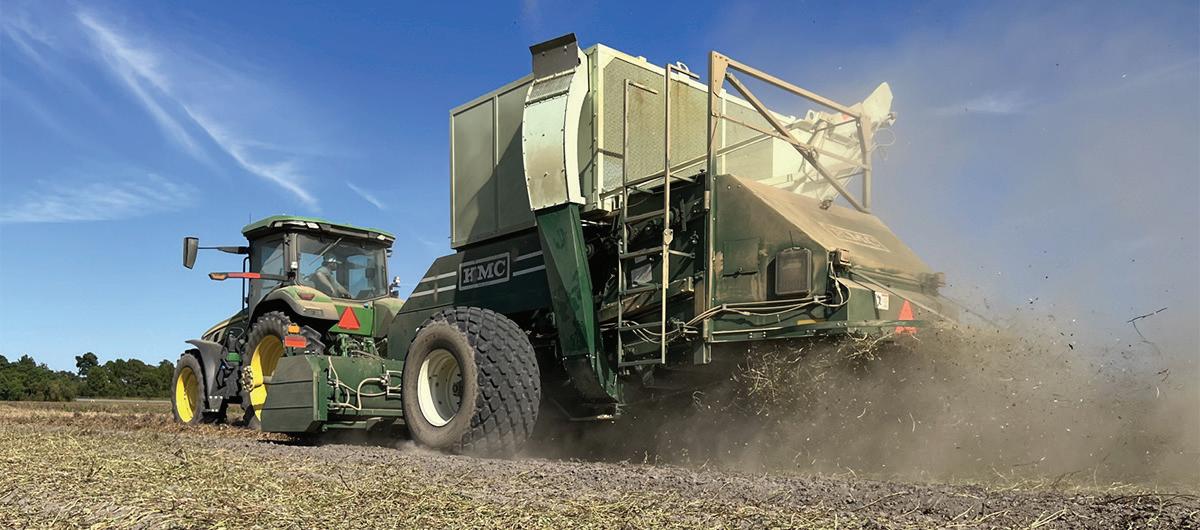
Estimating Peanut Harvest Losses
UGA’s Simer Virk and Scott Tubbs note that during peanut harvest, losses are common and can be caused by improper setup, operation and/or performance of the harvest equipment. While harvest losses cannot be not completely eliminated, it is always good to understand the level of losses so appropriate adjustments to harvest equipment settings, operational parameters or harvest decisions can be made to keep these losses to the minimum.
JUNE 2024 • THE PEANUT GROWER / 11 | @PEANUTGROWER
Follow The UGA Extension Precision Ag Blog
Well Deserved Recognition
The Wild Arachis Species Special Session of the APRES annual meeting is now named to honor Dr. Charles Simpson.
The American Peanut Research and Education Society recently announced that the 2024 annual meeting would host the inaugural Charles Simpson Wild Arachis Species Session. The APRES annual meeting is July 9-11 at the Omni Oklahoma City hotel. This groundbreaking session, dedicated entirely to wild peanut species presentations, honors the profound contributions of Dr. Charles Simpson to peanut research worldwide.
The idea behind naming the session for Dr. Simpson, professor emeritus in the Texas A&M College of Agriculture and Life Sciences Department of Soil and Crop Sciences plant breeding program, came from Shyam Tallury, curator of the U.S. Department of Agriculture’s peanut collection. At the 2023 APRES meeting in Savannah, Georgia, Tallury made a presentation about Dr. Simpson and proposed naming the wild species session in his honor. The legacy of Dr. Simpson is immense and continues to this day.
“His research contributions with peanut wild species collections are unparal-
The Legacy of Dr. Charles Simpson
• Dedicated and passionate about the preservation of the valuable Arachis species materials for almost 50 years.
• A pioneer in the area of peanut genetic resources conservation and use.
• Participated in 28 collection expeditions spanning from 1977 through 2016 in South America.
• Completed expeditions ranging from five to 62 days, with most between 40 and 50 days.
• A two-fold contribution to the USDA peanut collection: Germplasm of both cultivated and wild species accessions to the genebank collection; taxonomic classification and characterization of the germplasm resources.
• One of the three current authorities in the world, along with Dr. Jose Valls from Brazil, and Dr. Guillermo Seijo from Argentina, on the taxonomy of genus Arachis.
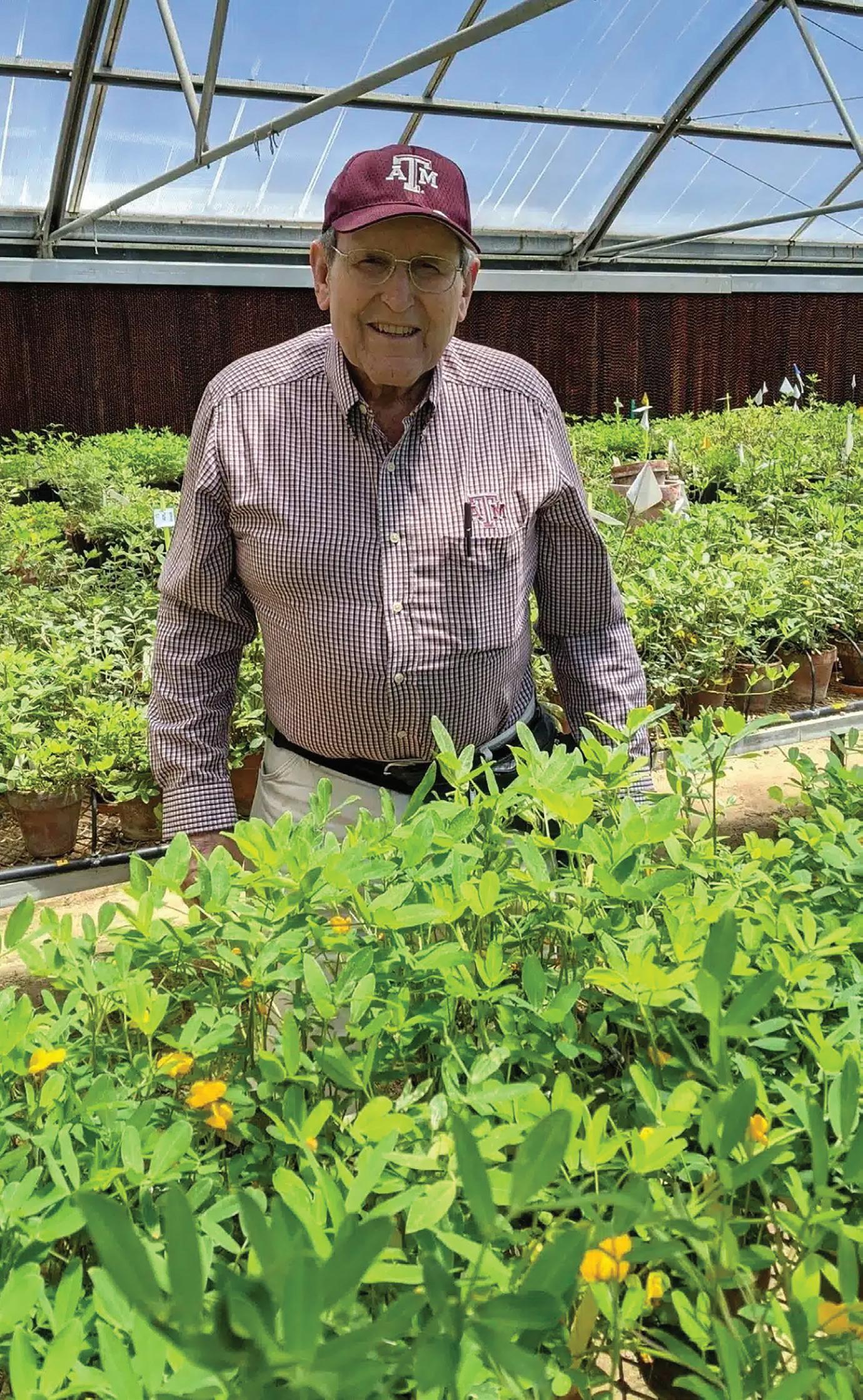
12 / THE PEANUT GROWER • JUNE 2024 PEANUTGROWER.COM
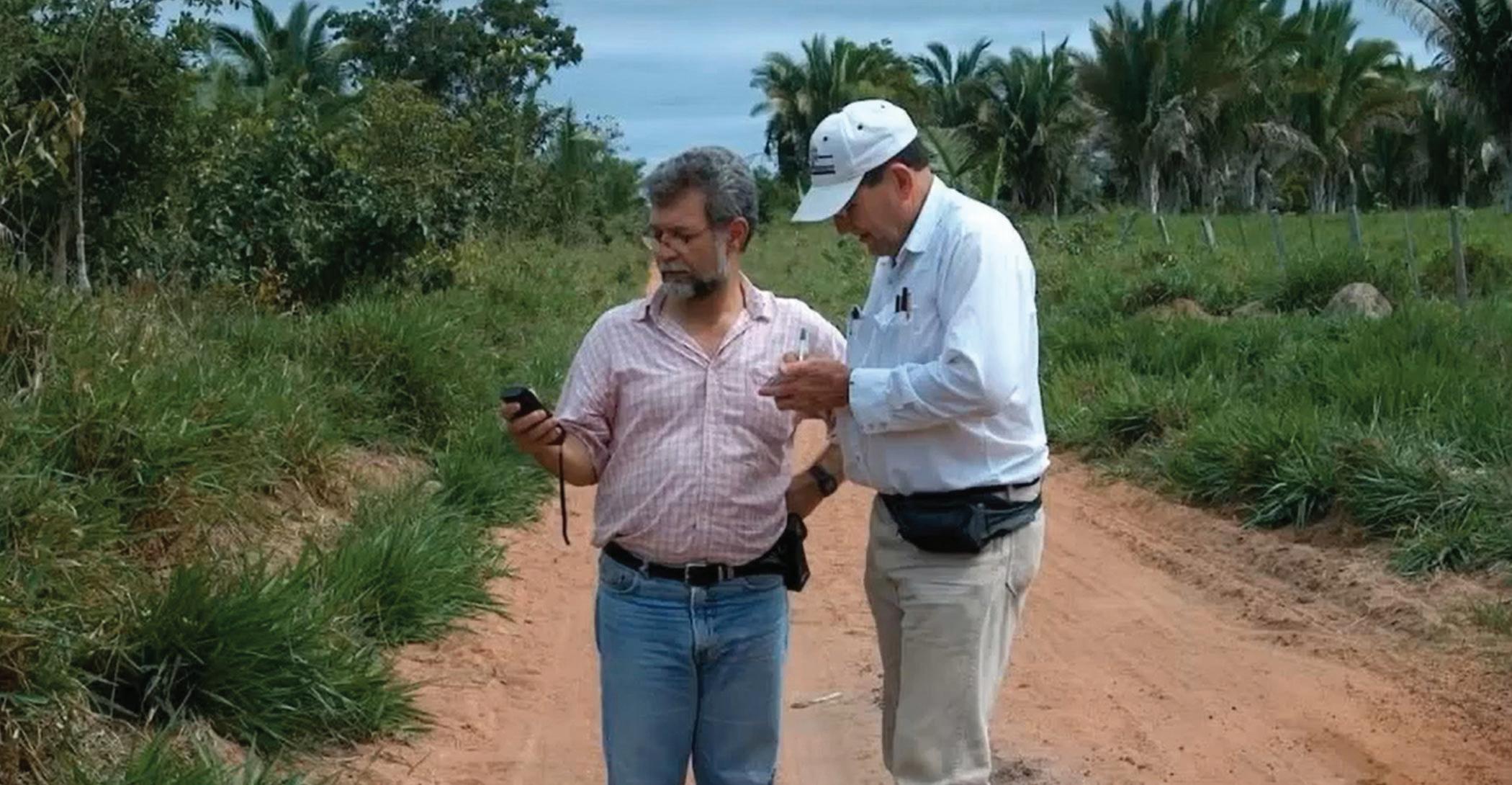
leled and undisputable, and without his collaboration and support, replenishment of new species materials into the USDA genebank collection wouldn’t be possible,” says Tallury.
Making A National Treasure
The Arachis Wild Species Collection, considered a National Treasure, is maintained in the USDA-ARS managed genebank in Griffin, Georgia. The collection contains about 9,000 cultivated species accessions and 550 wild species accessions. Germplasm is regularly requested by researchers and has contributed to the development of several important peanut cultivars in the United States.
“The germplasm collection is a testimony to the vision and dedication of several prominent national and international collectors with funding support from USDA, the International Board for Plant Genetic Resources and logistic support from the host countries,” Tallury says. “Prominent national collectors included Don Banks, Walton Gregory, Ray Hammons, Charles Simpson and David Williams.
“Among them, Charles Simpson has led the effort to replenish and restore the USDA Arachis wild species collection since 1977.”
Collection, Taxonomy And Continued Guidance
But Tallury says his impact goes beyond the accumulation of the accessions in the genebank. His early research with Arachis species led to the taxonomic understanding of the genomes and development of different introgression pathways that led to the production of interspecific hybrid populations by several researchers later.
“One of his major contributions was the release in 1993 of the tri-species derived amphidiploid with very high levels of root knot nematode resistance in peanut. Subsequently, a RKN resistant cultivar, COAN, was released by his group, which was later used in other breeding programs to release additional cul-
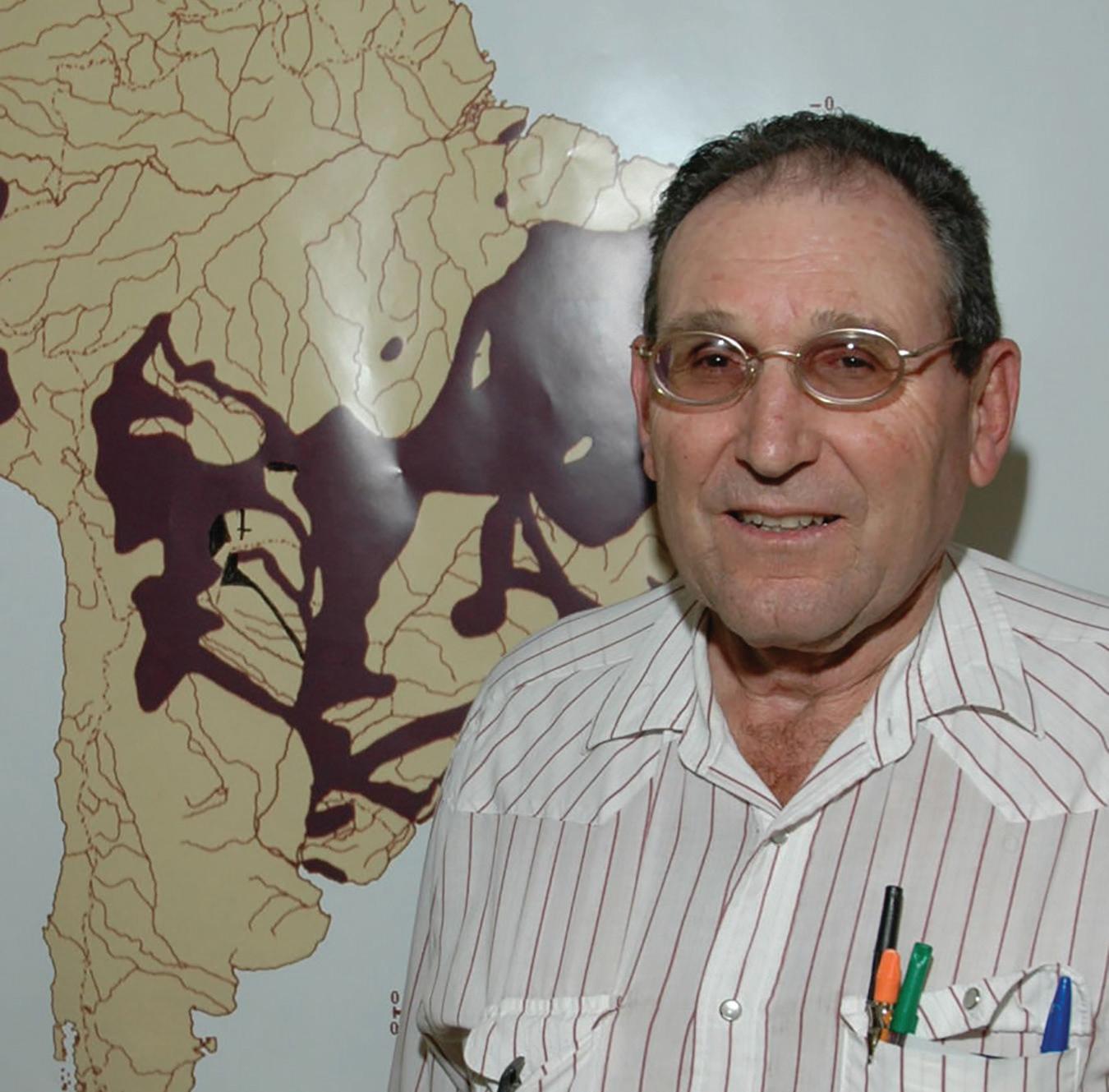
tivars with near immunity to RKN.
“With the current genomic revolution effort in peanut, characterization and use of Arachis wild species for peanut improvement has been gaining prominence lately,” says Tallury. “These research efforts wouldn’t have been possible without the genebank collection and Dr. Simpson’s contribution of Arachis species accessions.”
Even now when Tallury needs assistance or guidance with growing a wild peanut accession, Dr. Simpson is quick to respond with the expertise and experience for a more successful attempt. He is simply a pioneer in the area of peanut genetic resources conservation and use.
John Cason, assistant professor of Peanut Breeding and Genetics at the Texas A&M AgriLife Research station in
JUNE 2024 • THE PEANUT GROWER / 13 | @PEANUTGROWER
In Brazil, 2004, Dr. Simpson and Dr. Jose Valls use a new tool, GPS, to mark locations they had been to many times before. They also collected more wild species seed.
Stephenville, says Dr. Simpson’s priorities are faith, family, peanuts and football, in that order.
“If you know how much he loves peanuts, that will tell you how much he loves his family,” says Cason, who says he has spent more time with Simpson over the years than any other man, save his own father. “He has preached to me the mantra ‘know your plants’ for over 30 years, and I can honestly say I’ve never met anyone who knows more about peanuts. To this day, I still ask him questions on a daily basis, and he never fails to point me in the right direction.”
Support From The Peanut Research Foundation
While Tallury made the proposal for the Charles Simpson Wild Arachis Species Session at the 2024 annual meeting, APRES president-elect Rebecca Bennett, research plant pathologist with the USDA Peanut and Small Grains Research Unit in Stillwater, Oklahoma, says the Peanut Research Foundation is providing financial support.
“The Peanut Foundation is supporting this inaugural session by funding the travel of a special guest speaker and former colleague of Dr. Simpson, Dr. David Williams,” says Bennett.
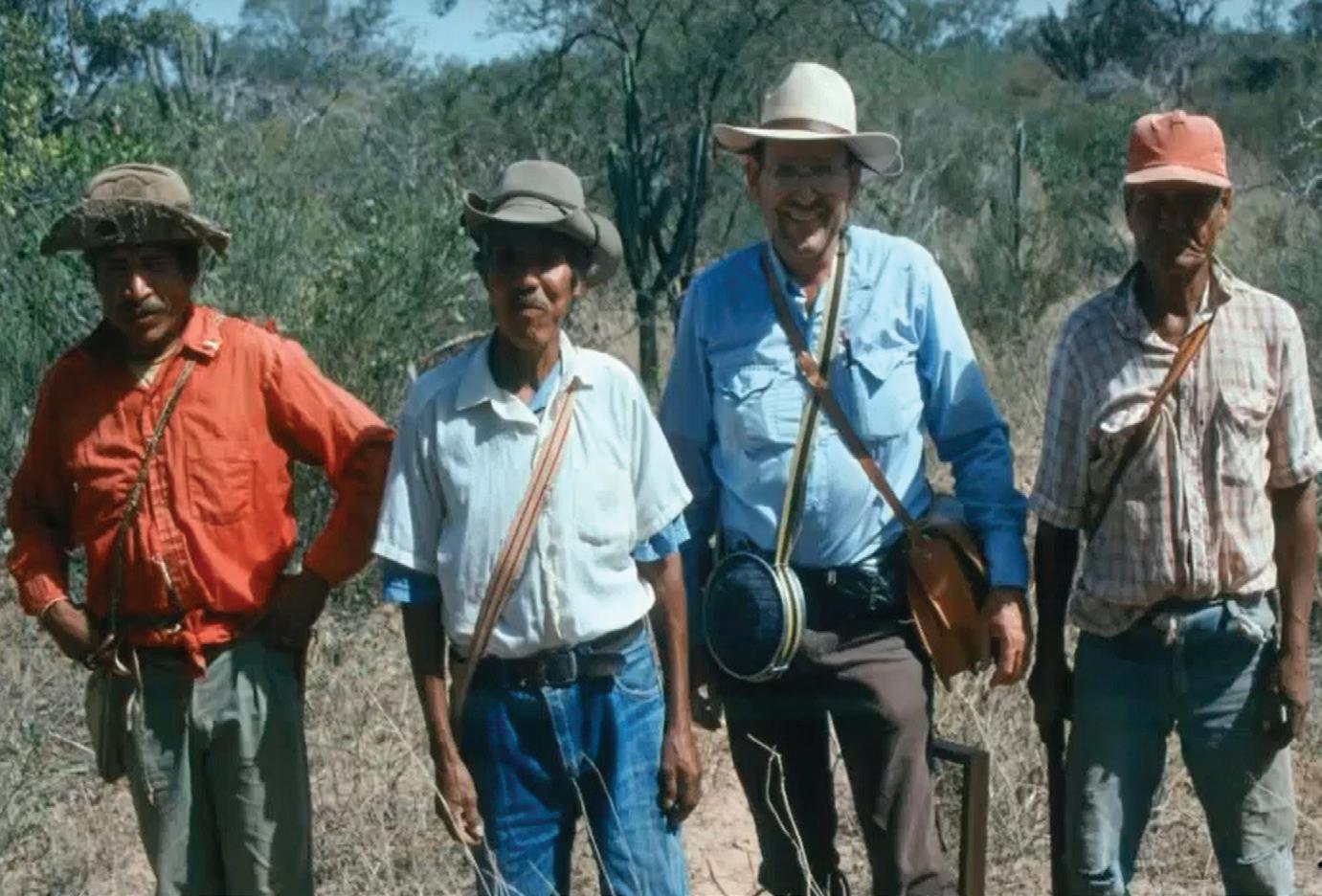
Dr. Simpson stands with three Guarani tribesmen in southeast Bolivia in 1994. Simpson sought their help in finding wild peanut species. When found, he dug into the soil and sifted out the seed. The tribesmen asked if they were edible and were excited to find out about this new source of food.
“The Peanut Research Foundation is proud to help support the inaugural session of the Charles Simpson Wild Arachis Species Session at the 2024 APRES Conference,” says Steven Brown, executive director. “The foundation is supporting research to utilize the treasure of genetic diversity in Dr. Simpson’s collection. His insight to identify and
preserve these species will pay huge dividends to the peanut industry.”
This premier event, which could not be more aptly named, promises to be an enriching and inspiring experience, bringing together researchers, educators and industry leaders from around the world to collaborate, learn and explore innovative research in the field. PG
Peanut Breeding Innovator Inducted Into The Georgia Agricultural Hall of Fame
An innovator in peanut breeding whose research revitalized an industry, William D. Branch, Georgia Seed Development professor in peanut breeding and genetics in the University of Georgia’s Department of Crop and Soil Sciences, was recently inducted into the Georgia Agricultural Hall of Fame at the 68th UGA College of Agricultural and Environmental Sciences Alumni Association Awards in Athens.
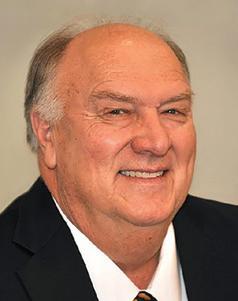
Established in 1972, the Georgia Agricultural Hall of Fame honors individuals making extraordinary contributions to agriculture and agribusiness industries in the state.
Inductees are nominated by members of the public and selected by the awards committee of the CAES Alumni Association. Those nominated must be of impeccable character, have outstanding leadership skills, made noteworthy contributions to Georgia’s agricultural landscape and been recognized for achievements in agriculture and other areas.
Immense Impact On The Southeastern Peanut Industry
William D. Branch became interested in plant breeding while growing up on a farm in south central Oklahoma where his family grew wheat and a few acres of peanuts. Following high school, he continued his education in agronomy at Oklahoma State University, earning his bachelor’s and master’s degrees and his doctorate
before taking a postdoctoral position at Auburn University. In 1978, Branch moved to Tifton, Georgia, to begin working with the UGA peanut breeding program at the Coastal Plain Experiment Station. Branch’s work with peanut cultivars has improved the profitability of peanut farming in Georgia, the Southeast and the world at large. Peanut cultivars developed by Branch account for more than 80% of the peanut acreage grown in Georgia and the Southeast. Branch has released 31 elite peanut cultivars and five improved germplasm lines and populations for use by fellow plant breeders. Two cultivars, Georgia Green and Georgia O6G, have been credited with saving the Southeastern U.S. peanut industry due to their resistance to Tomato Spotted Wilt Virus. In addition to disease resistance, the cultivars are designed to have higher yields and improved shelling efficiency to increase profitability without increasing input costs.
Between the release of Georgia Runner and the recent release of Georgia-18RU, there has been an increase in yield of 1,995 pounds per acre, equating to an increase in profit of $325 per acre. Today growers in Georgia make $220 million more per year than they did when the Georgia Runner was released. No one has had a greater impact on the top crop of the state’s leading industry than Branch, who has spent his career improving peanut genetics for the benefit of Georgians and the nation.
Article by Maria M. Lameiras, managing editor with the University of Georgia College of Agricultural and Environmental Sciences.
14 / THE PEANUT GROWER • JUNE 2024 PEANUTGROWER.COM
William D. Branch
Season Update
More frequent and heavier rainfall leads to more Valor injury and earlier disease pressure.
By Amanda Huber
Rain is a necessary element to peanut production. “If it don’t rain, it don’t matter,” was a favorite mantra of the now-retired University of Georgia Extension peanut specialist John Baldwin. Even so, there are issues caused by rain that producers should be ready for. Whether it is the onset of disease because of increased spore dispersal or herbicide injury to seedlings, awareness of these potential problems is the first step to mitigating the harmful effects.
Be Ready For Fungicide Applications
Bob Kemerait, University of Georgia Extension plant pathologist, says if it continues to rain into late May and early June, conditions will be more favorable for diseases like leaf spot.
“The rain action, the mechanical splashing on seedlings, actually aids in disease spore dispersal,” he says. “If we stay in the weather pattern we’re in now, which is a little more rainy, it is probably best to start a leaf spot program earlier than later.
“Coming into a period with increased rain activity, don’t delay in getting started on your fungicide applications.”
Another factor to watch out for is the higher temperatures.
“If we continue to have increased moisture but also higher temperatures, that could set off an early white mold epidemic,” Kemerait says. “Pay attention to the weather, temperature and rainfall. Start with fungicides as on time as possible.”
Fungicides that can be used at 30 days after planting include tebuconazole, Elatus or Excalia, he says. “Lucento and Priaxor also have some white mold activity to get started early.”
Yield Is Not Often Affected By Valor Injury
Wade Parker, UGA Extension Southeast district area agronomist, says the East Georgia area was quite wet midway through planting.
“The first few weeks of planting were dry, but as of the last few days, we got an inch and a half to two inches of rain and even a report of 2.25 inches,” he says. “Planting progress is about 40% to 45%. It’s amazing how fast these 12-row planters get things done.”
Parker says seed are germinating well, and stands look beautiful.
“This rain will likely give us Valor injury, but that is something we know they’ll grow out of. We know that we need the weed control that Valor gives,” he says.
Valor injury is absolutely expected with the rain, says UGA Extension weed specialist Eric Prostko.

“What 27 years of research on this product has shown us is that 99% of the time peanuts recover without yield loss,” he says. “Injury is going to happen with this amount of rain, especially in fields where peanuts were just coming out of the ground.”
An Early Post Herbicide Recommendation
Prostko says growers who have missed the recommended application timing for applying Valor, Strongarm and Prowl or Sonalan preemergence should not panic.
“My suggestion would be to let the peanuts emerge, then treat herbicide ‘naked’ fields with an early post application of Gramoxone plus Storm or Basagran, with Zidua or Anthem Flex and a non-ionic surfactant, a recommendation that can be found on page 221 of 2024 UGA Pest Control Handbook.”
Prostko says he usually does not have a preference between the Group 15 herbicides (Anthem Flex, Dual Magnum, Outlook, Warrant, Zidua).
“However, in fields that were not treated with any Prowl or Sonalan, I do prefer Anthem Flex or Zidua as the first early post treatment because these herbicides provide slightly better control of Texas panicum, also called bullgrass or buffalograss.”
In trials with no preemergence herbicides, Prostko says he has been able to obtain very effective weed control with the early post recommendation, thought it may not be ideal.
Prostko offers one last reminder about rains. “Depending on timing, at some point that peanut may be flat on the ground laying in whatever is in the water around it, whether it is herbicides or disease spores. Just keep that in mind.” PG
JUNE 2024 • THE PEANUT GROWER / 15 | @PEANUTGROWER
UGA Extension weed specialist Eric Prostko says 99% of the time peanuts recover from Valor injury without yield loss.
Thank You, Dr. Brandenburg
Your contributions to the industry and especially the peanut growers of North Carolina are sincerely appreciated.
By David Jordan, North Carolina State University Extension Agronomist
Editor’s Note: North Carolina State University Extension entomologist Rick Brandenburg is retiring in 2024 after many years of dedicated service to producers. The following is a tribute to his work and friendship over the years.
IRick Brandenburg
’ve known and worked with Rick Brandenburg since 1996 when I first joined the faculty at North Carolina State University. Our history goes back even further. During the drought of 1980, in northeastern North Carolina, while I was trying my best to block curve balls on a hard and dry infield during American Legion baseball games in Edenton, Rick was about 10 miles north in the Rocky Hock area leaning over in peanut fields studying the two-spotted spider mite as a doctoral student. I think one day, the center of origin of this pest, known as “them red spiders” by the locals, will be traced to a sand hill in that area.
• Bachelor of Science, Purdue University, 1977
• Ph.D, North Carolina State University, 1981
• University of Missouri faculty, 1981-1985
• North Carolina State University faculty, 1985-2024
• University of Pretoria visiting professor, 1999-2000
• American Peanut Research and Education Society Fellow, 2003
• Entomological Society of America Fellow, 2004
• William Neal Reynolds Professor of Distinction, NCSU, 2007
• President, American Peanut Research and Education Society, 2018
Years later, Rick and I would begin a long journey together addressing pest management issues in peanuts. Rick has made many contributions to the peanut industry. His focus has been spider mites, thrips, southern corn rootworm, caterpillars and worms later in the season. Along with the now-retired Virginia Tech entomologist Ames Herbert, Rick developed the southern corn rootworm index and was the driving force behind the tomato spotted wilt index we use today. Rick has worked hard to help Cooperative Extension continue its original mission through changing times with a focus on the end user – the peanut grower.
Rick Brandenburg is who I would call an investor, and his investments go deep. They touch many, and they transverse time and geography. He knows that the future rests on how one generation invests in the next one.
Rick and I spent a lot of time in peanut fields and at training programs in North Carolina. But as time went by and the green
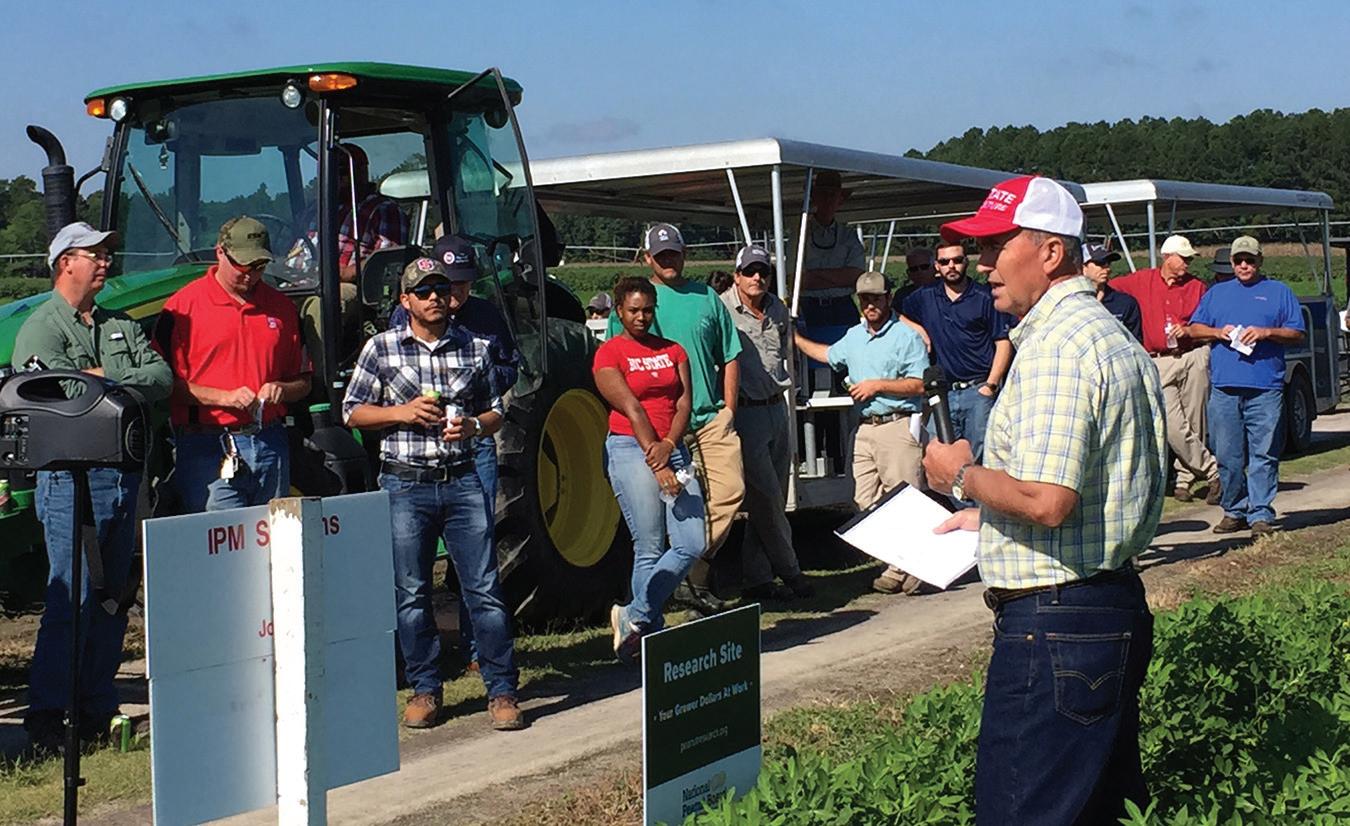
industry in North Carolina grew, it seemed as though our conversations were mostly on dusty roads in West Africa on the way to and from peanut fields. Rick understood that you can help the people in North Carolina and in other parts of the world, too. It’s not an either-or proposition. Here are quotes from five people, among the many, who Rick has touched with his time, wisdom and generosity demonstrating this fact.
‣ MARK ABNEY
University of Georgia Extension Entomologist
I have nothing but positive things to say about Rick Brandenburg. I always found him to be a voice of reason and practicality in the entomology department at NCSU. He never spoke just to hear himself talk or to show how smart he is. When Rick said something, it mattered, and he wasn’t scared.
I am not sure when I learned that Rick had been George Kennedy’s student, but I remember when I was a post doc with George, also a distinguished former NCSU entomologist, he told me that Rick was one of the most capable students he had ever had. This is high praise coming from George Kennedy.
As a new peanut entomologist, I called on Rick several times for advice, and he was always willing to share his experiences. Rick is an excellent entomologist and a great man.
‣ BRIAN ROYALS
North Carolina State University Technician
It has always been an adventure to work with Rick. There was never a dull moment on our road trips to our peanut fields. Early in our drive, Rick would undoubtedly inquire,
16 / THE PEANUT GROWER • JUNE 2024 PEANUTGROWER.COM
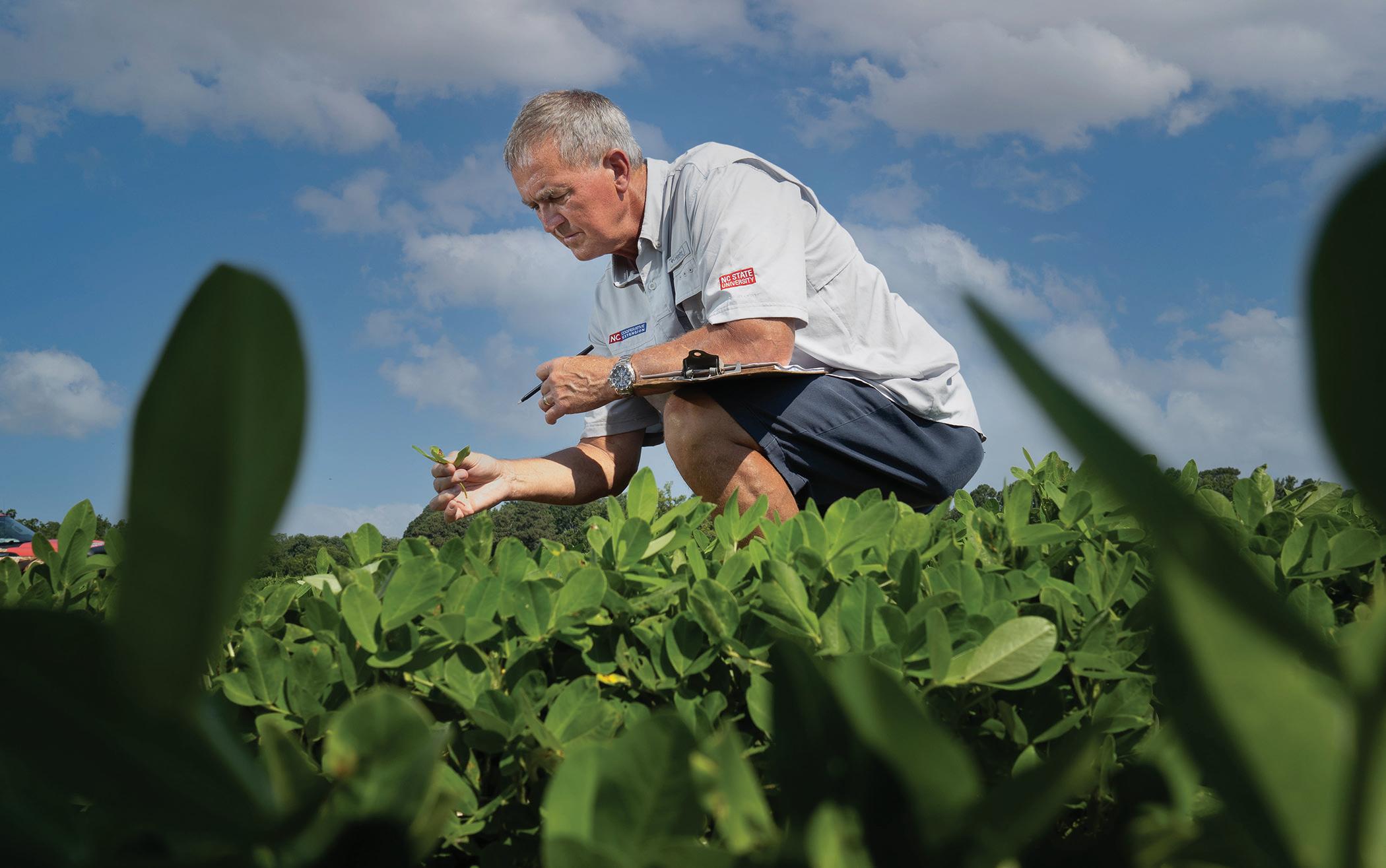
“Are we there yet?” And “Just up the hill and around the corner” would be my standard response. I could buy myself at least an hour with this response.
He frequently had other questions on our research excursions besides that one. “Can we stop at the next convenience store so I can get a Diet Coke and peanut M&Ms?” would soon be asked as well. When I see these two snacks, I can’t help thinking of him and how much fun we have had together.
These are only a couple of the thousands of memories I have of my road trip adventures with Rick.
‣ BARBARA SHEW
North Carolina State University Plant Pathologist (retired)
I’ve always been impressed (and a bit envious) of Rick’s ability to communicate with all kinds of people. He has a knack for making the listener feel as if they were engaged in a conversation rather than being talked at.
During Rick’s time as Extension leader in our department, he likewise got his points across while also being a good listener. Rick was patient and tactful during heated discussions and was able to steer them in a positive direction.
Finally, Rick’s sincere dedication to international work is evident. Rick has made a real difference in the world, and his efforts will be missed.
‣ WEZI MHANGO
Lilongwe University of Agriculture and Natural Resources, Bunda College, Lilongwe, Malawi, Associate Professor of Agronomy
I have worked with Dr. Rick Brandenburg on the Peanut Innovation Lab project in Malawi since 2015. Dr. Brandenburg is such a great person to work with, a good mentor and an
enabler. Over the years, I have learned so many things from his vast knowledge and experience in peanut research. Through interactions with Dr. Brandenburg, I have also learned skills on how to build partnerships with other institutions.
Lastly, through his support for graduate student training and mentorship, Dr. Brandenburg has contributed capacity building of scientists in the agricultural sector. Dr. Brandenburg’s commitment to research, enabling others and mentorship will always be remembered.
‣ MIKE OWUSU-AKYAW
Council for Science and Industrial Research, Crops Research Institute, Kumasi, Ghana, Entomologist (retired)
The initial budget from the Peanut Collaborative Research Support Program, or Peanut CRSP, Project more than 20 years ago was $5,000 for two research institutes. While Rick cautioned me to stay focused with the limited funds, over time the project grew and covered all of the essential disciplines associated with peanut. Persistence in building and maintaining relationships overcame funding limitations and strengthened our capacity to address the needs of the peanut growers throughout Ghana.
Rick was central to the life of the project. Our work together covered trips to peanut fields, vehicle repairs in rural villages late at night and a featured spot on a Ghana Broadcasting Corp. TV show that included much-needed makeup. Anytime we experienced tense situations in the field, Rick would seize the moment with a well-timed joke to calm us down. He was a great motivator for all of us on the team. My performance as Crops Research Institute coordinator and success professionally was influenced in major, positive ways by Rick. I congratulate Rick for being able to retire peacefully and wish him very well now and forever. PG
JUNE 2024 • THE PEANUT GROWER / 17 | @PEANUTGROWER

With our team’s collective 200+ years tied to agricultural production, we believe in what we do.

We make it our mission to provide profitable production strategies to our farmers with information to improve their bottom lines.
Our seasoned editors cover every stage of production — from land preparation, to seed selection, to crop protection through harvest.

Contact Associate Publisher/Sales Scott Emerson at 386-462-1532 or semerson@onegrower.com to advertise

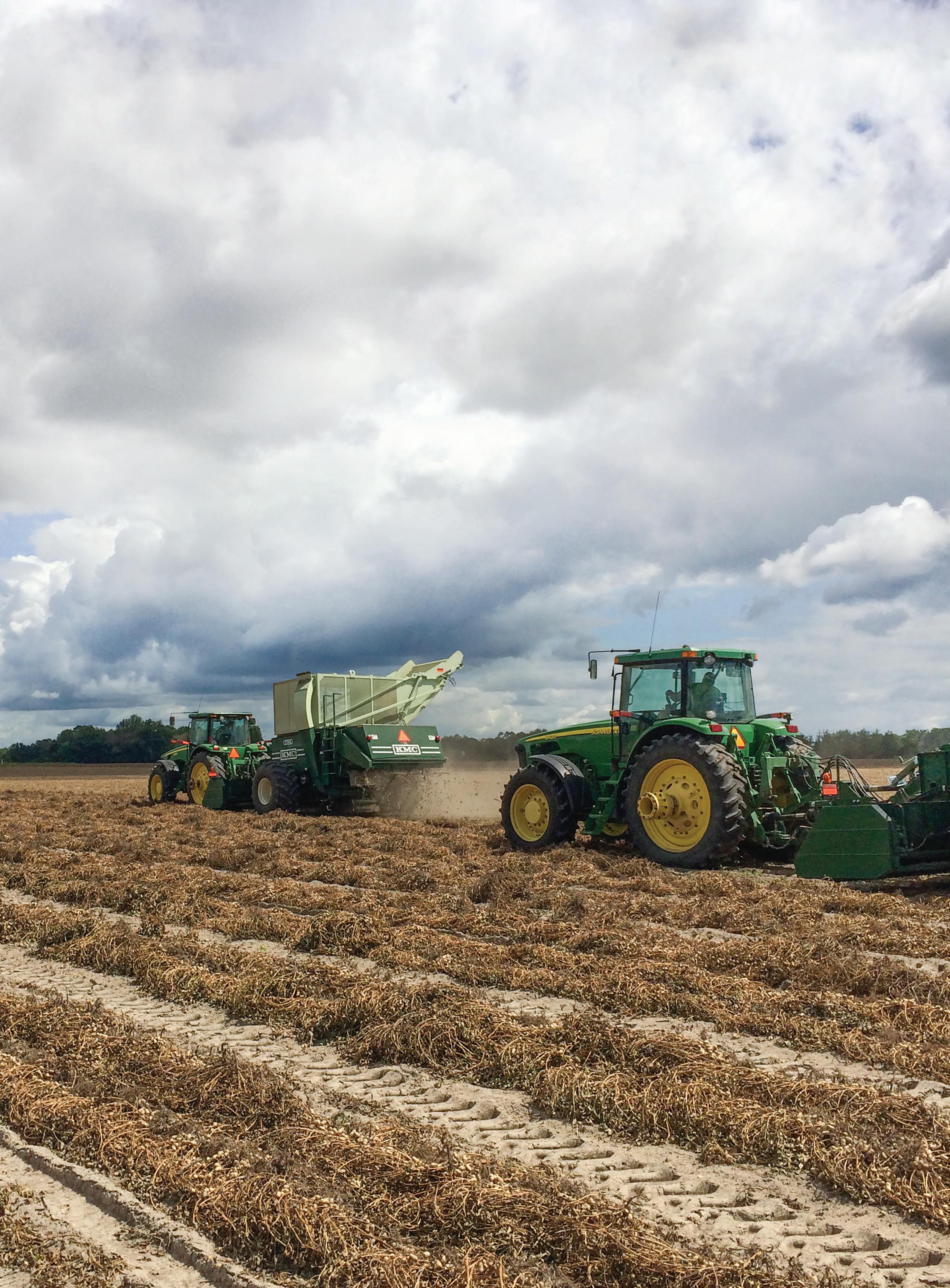
It’s
do,
are.
not just what we
it’s who we
www.peanutgrower.com@PeanutGrower
New Variety Honors Avid Grower
Named for Arnold ‘Arnie’ Forrester, the University of Florida released a high-yield potential cultivar with normal oleic oil chemistry.
If ‘Arnie’ the peanut cultivar is half as good of a peanut variety as Arnie Forrester was a man, it will be truly outstanding, says folks who knew him.
Arnold “Arnie” Forrester was a farmer in Jackson County, Florida, until his untimely passing Jan. 1, 2022. Until then, he was an outstanding farmer and strong collaborator with the University of Florida’s Institute of Food and Agricultural Sciences, always searching for new technology to improve his farming operation.
A Tribute To Dedication
Sudeep Sidhu, regional specialized Extension agent with the North Florida Research and Education Center in Suwannee Valley, says he met Arnie in early 2021.
“Within minutes of our meeting, we were drawing maps on the ground with our fingers, although we were right next to his office and could have drawn on paper or used Google Earth,” Sidhu says of his willingness and excitement to be part of the scientific process.
“For a cotton project, I always prefer to be out in the field on the day of planting so that I can mark the first row and establish my studies on the same rows as the cotton picker would be during harvest. Due to some delays, Arnie was behind with cotton planting in our designated field that year. He ended up planting the field at midnight and texted me that he had flagged the first row for me.
“The next day I went to establish my treatments, and I won’t be able to forget what I saw. Arnie did flag the first row, not for one pass but for 12 consecutive passes,” Sidhu says. “He wanted to make it easy for me and planting well into the middle of the night, he stopped 12 times to flag the first row at each pass. That

was his dedication and commitment to research, and, above all, his kind, wonderful and helping heart to make it easy for others.”
Significant Tolerance To TSWV
UF peanut breeder Barry Tillman says it is rare to find such a perfect example of an engineer-farmer, such as Arnie was.
“As an engineer, he was meticulous, deliberate and analytical with a strong desire to learn more and more, to support his decision-making process. As a farmer, he was hard-working, determined and studious, always executing his plan and observing the crop to make sure it had everything needed.”
As for the runner-type peanut variety, Tillman says its characteristics include high-yield potential, high total sound mature kernel grade and excellent tolerance to Tomato Spotted Wilt Virus. The cultivar, ‘Arnie,’ has normal oleic oil chemistry, making it the second release from UF-IFAS in recent years with this trait, a nod to the preference of some peanut butter manufacturers.
“In 23 Florida tests over five years and three locations, the pod yield of ‘Arnie’ was greater than that of Georgia-06G, Tillman says. “Grade was slightly greater than Georgia-06G.”
However, it’s the tolerance of ‘Arnie’ to TSWV that is one of the variety’s most impressive features, he says.
“In tests conducted in Florida and Georgia, the spotted wilt disease ratings of ‘Arnie’ were significantly lower than Georgia-06G, and similar to Georgia12Y, which has the best tolerance to spotted wilt among cultivars grown today,” Tillman says. “‘Arnie’ is a medium-maturing variety requiring about 140 days in Florida under irrigation. It has a relatively small runner-size seed at about 700 sound mature kernels per pound and produces about 38% medium seeds on an in-shell basis.”
Tillman says another unique feature of the variety is that about 15% of its pods contain three seeds. Seed supply of ‘Arnie’ will be limited in 2024, with about 90 acres of Foundation seed grown in 2023. PG
JUNE 2024 • THE PEANUT GROWER / 19 | @PEANUTGROWER
This picture shows an example of two- and three-seeded pods on the same plant produced by the peanut variety ‘Arnie.’
BARRY TILLMAN, UF/IFAS


Peanut Pointers
Meeting The Calcium Need For Good Pod Fill
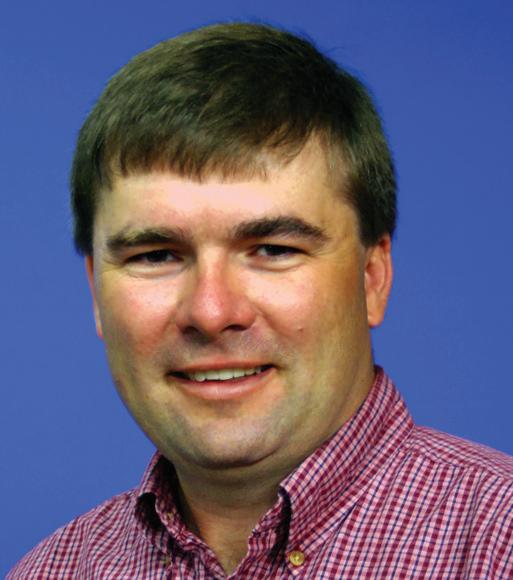
Many growers are trying to reduce their input costs. In trying to do so, questioning the need for gypsum and/or considering using something cheaper or easier is always part of the equation. The value of calcium and the need to determine if a crop has adequate calcium levels has remained consistent, year after year. Here is an excerpt from a county agent article written by former University of Georgia Extension peanut specialist John Beasley and current UGA soil scientist Glen Harris from 2009 that still rings true today.
“To determine if you need calcium, producers need to take a “pegging-zone” sample to determine if there is adequate calcium for pod development, increased yield and improved grades. The pegging-zone sample is taken at the three-inch depth. The calcium that peanut pods take up is absorbed directly from the soil surrounding the pods. The peanut plant cannot translocate calcium in the plant down into the pod. Do not take the sample any deeper than three inches.
“Pegging-zone samples need to be taken as soon after emer-
gence as possible to get the results back and the calcium applied by the time the plants initiate blooming. Our standard UGA recommendation for calcium nutrition is to add supplemental calcium in the form of gypsum (land plaster) if the sample from the three-inch depth has less than 500 pounds per acre of calcium or if there is less than a 3:1 ratio of calcium to potassium.
“Another concern we have is that some liquid products are being promoted as a source for amending calcium deficiencies. The UGA recommendation for calcium nutrition for peanuts being grown for commercial, edible use is to apply 160 to 200 pounds per acre of elemental calcium per acre. Most gypsum products are about 20% calcium, so it requires 800 to 1,000 pounds per acre of gypsum to meet that requirement. If a field is being grown for seed production, then the rate is doubled to 1,600 to 2,000 pounds per acre.
“If one of your producers is asked to apply a liquid product, then they need to know what percent calcium is in the product and what the recommended rate is. For example, if a liquid product has 10 pounds of calcium per gallon, then it would take 16 gallons per acre of the product to deliver the minimum requirement of 160 pounds of calcium. Some liquid products list the calcium in the product as a percentage. For example, if the product is listed as 10% calcium and the liquid material weighs about 10 pounds per gallon, then you are getting about one pound of calcium per gallon and would need 160 gallons per acre to meet the minimum requirement. Be careful of products that state the calcium is absorbed by the tissue for use
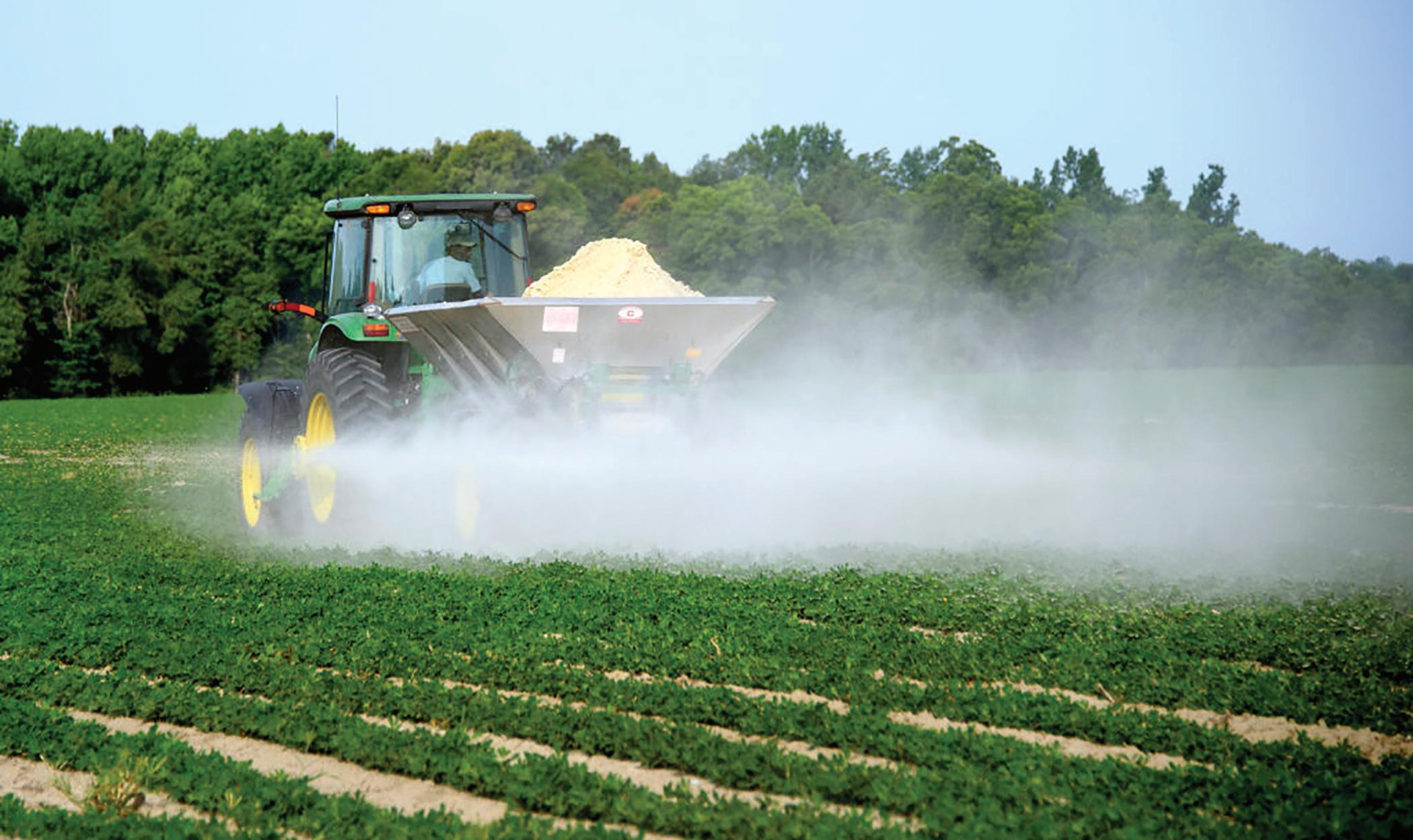
20 / THE PEANUT GROWER • JUNE 2024 PEANUTGROWER.COM
SCOTT MONFORT
University of Georgia
Extension Agronomist


Peanut Pointers
by the pods. The plant cannot translocate the calcium from the leaf tissue to the pods.
“There are also some lime products being pushed as a pegging time calcium amendment. Lime is calcium carbonate compared to gypsum (land plaster), which is calcium sulfate. The calcium carbonate (lime) will provide calcium in an available form eventually, but if applied after planting, the calcium becomes available much later than needed. If the lime was applied before planting, then it has time to break down into an available form. This also goes for ‘fine’ lime, which has smaller particles. The bottom line in calcium nutrition is that if the calcium source is applied at early bloom, it needs to be gypsum at the rate of 160 to 200 pounds per acre of calcium or double that rate for seed production. Do not apply a liming material at early bloom or pegging.”
As always, contact your local county Extension office if you have any questions.
Reminders With Recent Rains

I feel that many producers may be behind on finishing up planting this year due to the rains during the middle of May. Early in the peanut planting season, we had good conditions coupled with warm soil temperatures, which led us to some nice-looking peanut stands to start the season. I say that some may be behind, depending on the amount of rain during mid-May. Many were out of the field due to the wet conditions from May 10-22. However, we know as well that song by Luke Bryan, “Rain is a Good Thing.” Many farmers had stopped planting waiting on moisture right before this time.
Timing is everything in farming, and this year like many other times in the past, if you didn’t start early you wound up late. Therefore, if you’re in this category, first of all, you’re not alone. Hopefully, the weather will be the opposite of last year and late peanuts will be fine as long as we have moisture later during the growing season. Now, with planting finishing up, many farmers will have a pretty large planting gap across their acreage this year.
Don’t forget how long it’s been since the first planting. With higher temperatures we have seen coupled with this moisture and humidity early, we will have to take the necessary precautions and start treating with fungicides early to protect the crop this year.
Also, some folks like to put gypsum out really early in the season; however, if you got seven to 10 inches of rain during the middle of May, remember, gypsum is very water soluble. Therefore, if you did apply it early, you may have very well lost some of it and need to reapply.
More Isn’t Always Better

When June comes around, there are key inputs and practices that need our attention in a timely manner. One is firming up weed control. Herbicides applied at planting as well as early postemergence applications have hopefully been successful, but there is a lot of season remaining. Not only do weeds compete with peanuts for light, water, water and nutrients, plus space and essential gases like CO2 as well, but they also interfere with digging and vine inversion and can keep fungicides and insecticides from reaching the right place in the canopy.
We recommend overlapping residuals for control of weeds. Complement your preplant burndown or preplant incorporated sprays and herbicides applied right after planting (preemergence) with additional residual herbicides applied with contact herbicides (paraquat plus Basagran mixtures and PPOinhibiting herbicides), Cadre/Impose and clethodim products. This can seem expensive, but early season weed control is critical, and we need season-long control for efficient digging. If we don’t disturb the soil, we will have controlled the major flushes of weeds with overlapping residual herbicides.
A second important practice is to control thrips with postemergence insecticides. Be timely with these sprays. By the time you read this, the early planted peanuts will have already needed follow-up sprays of insecticides. Don’t spray paraquat on peanuts with significant injury caused by thrips. You will get a major yield hit in many cases.
For Virginia-market types and large-seeded runner-market types, apply gypsum at rates recommended by Cooperative Extension. Rates for various products can be found in the North Carolina production guide “2024 Peanut Information” on all Virginia-market types. I recommend at least half that rate on runner-market types. There is a tendency to apply gypsum in early June.
Sometimes peanuts are very small at that point in the season, and big rains can wash the gypsum from the top of the row into the furrow since many acres in our region are planted on beds. I suggest later applications when peanut plants are bigger. The plants minimize washing of gypsum from where it is needed if you get heavy rains, and the alternate application increases the likelihood that adequate calcium will be in the pegging zone throughout the season.
At times, we think that more gypsum than the recommended rate gives us insurance. However, in some of our research, we find that rates higher than the ones we recommended can actually decrease yield, if we have low-pH soils. I do not recommend higher rates than what we have in the guide. There
JUNE 2024 • THE PEANUT GROWER / 21 | @PEANUTGROWER
DAVID JORDAN North Carolina State University Extension Agronomist
KRIS BALKCOM Auburn University Extension Specialist


Peanut Pointers
Check For Active Nodulation

Most peanuts in the Southwest have been planted. June is a good time to make an initial assessment of peanut nodulation. Peanuts form a symbiotic relationship with Rhizobium spp. and fix atmospheric nitrogen, if an inoculant was properly applied at planting.
A study conducted in England showed effectively nodulated peanuts with supplemental nitrogen fertilizer were more adaptable to hot environments than those relying solely on high amounts of nitrogen fertilizer without inoculation. This could be associated with more efficient nitrogen formation by Rhizobium spp. The study is highly relevant to Southwest peanut growing conditions, where the top four inches of soil temperature peaks at 97 degrees Fahrenheit in the growing season. (Photo 1)
To assess the early season nodulation status in your peanuts, carefully dig plants and count the number of active nodules. Active and healthy nodules should appear reddish pink inside due to the reaction of leghemoglobin (Photo 2). If the center of nodules is dark green and/or black, the rhizobia is inactive. Check to see that the plant has more than 20 active nodules in five to six weeks after planting. If the number of active nodules is less than 10, peanuts will benefit from the mid-season nitrogen program. Applying 10 to 20 pounds per acre of supplemental nitrogen should be suffi-
will not be a yield increase above the recommended rate, and in areas of the field with lower pH, yields might be lower than yields without gypsum.
Staying ahead of micronutrient deficiencies is important. In fields with high pH, we need to address manganese deficiencies early, and peanuts might need multiple applications. Make sure the products you purchase deliver adequate manganese and boron. There is not a magic formulation on the market. The formulation you use has to have enough micronutrient to make a difference. We also cover some of these products in “2024 Peanut Information.”
As we move into late June and early July, putting a solid program in place for leaf spot and stem rot management is critical. In North Carolina and Virginia, we generally have a five-spray program that begins at the R-3 stage of peanut growth and development, but no later than July 10, if you are spraying on a 14-day schedule. We have weather-based advisories for leaf

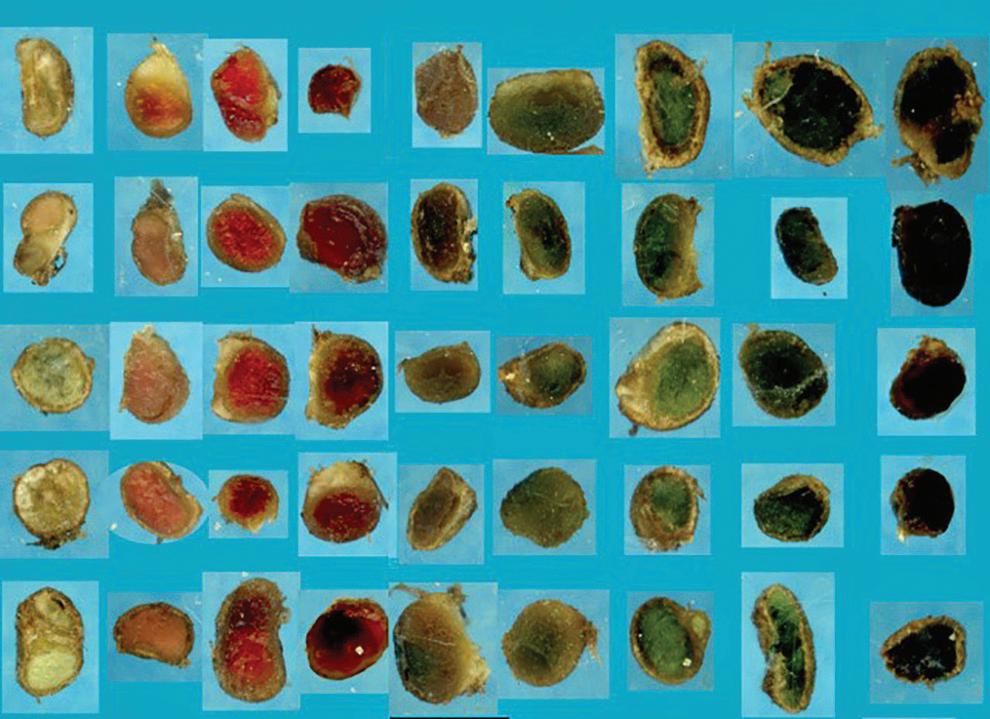
decay.
cient. Do not exceed 50 pounds per acre as excess nitrogen may increase the chance of pod rot later in the season.
spot that can help target the timing of sprays. The first and last sprays need chlorothalonil — multiple formulations are available. There are many options for sprays two, three and four to control stem rot and leaf spot. Some fungicides provide protection from leaf spot and stem rot for different lengths of time. The keys are to make sure there are no gaps in protection and resistance management is practiced by using the correct fungicide rate, applying the number of applications based on recommendations and alternating sites of action.
Finally, there is a great deal of overlap between sprays for weeds, insects and diseases and products we apply to address nutrient deficiencies and manage vine growth. Before you put a host of products in the tank at the same time, ask around and make sure the products are compatible. We don’t want to get less control than desired, more crop injury than we can stand, and we certainly don’t want to have to discard many acres of pesticides that settled out in the tank or replace parts of sprayers.
22 / THE PEANUT GROWER • JUNE 2024 PEANUTGROWER.COM
EMI KIMURA Texas A&M AgriLife Extension State Extension Peanut Specialist
Soil temperatures in the top four inches in Seminole, Texas.
UF EXTENSION
From left to right, examples of nodule internal color representing not yet active rhizobia, increasingly active, fully active and darkening green to black, representing senescence and






Scan the QR code with your phone to renew today for FREE! To advertise, contact Associate Publisher/Sales Scott Emerson, 386-462-1532 or semerson@onegrower.com peanutgrower.com PeanutGrower @PeanutGrower @ThePeanutGrower
Since 2001, the has invested more than �36 million National Peanut Board in food allergy research, outreach and education. Learn more at NationalPeanutBoard.org





























 Amanda Huber Editor, e Peanut Grower
Amanda Huber Editor, e Peanut Grower








 J. Tyron Spearman Contributing Editor, e Peanut Grower
J. Tyron Spearman Contributing Editor, e Peanut Grower




































